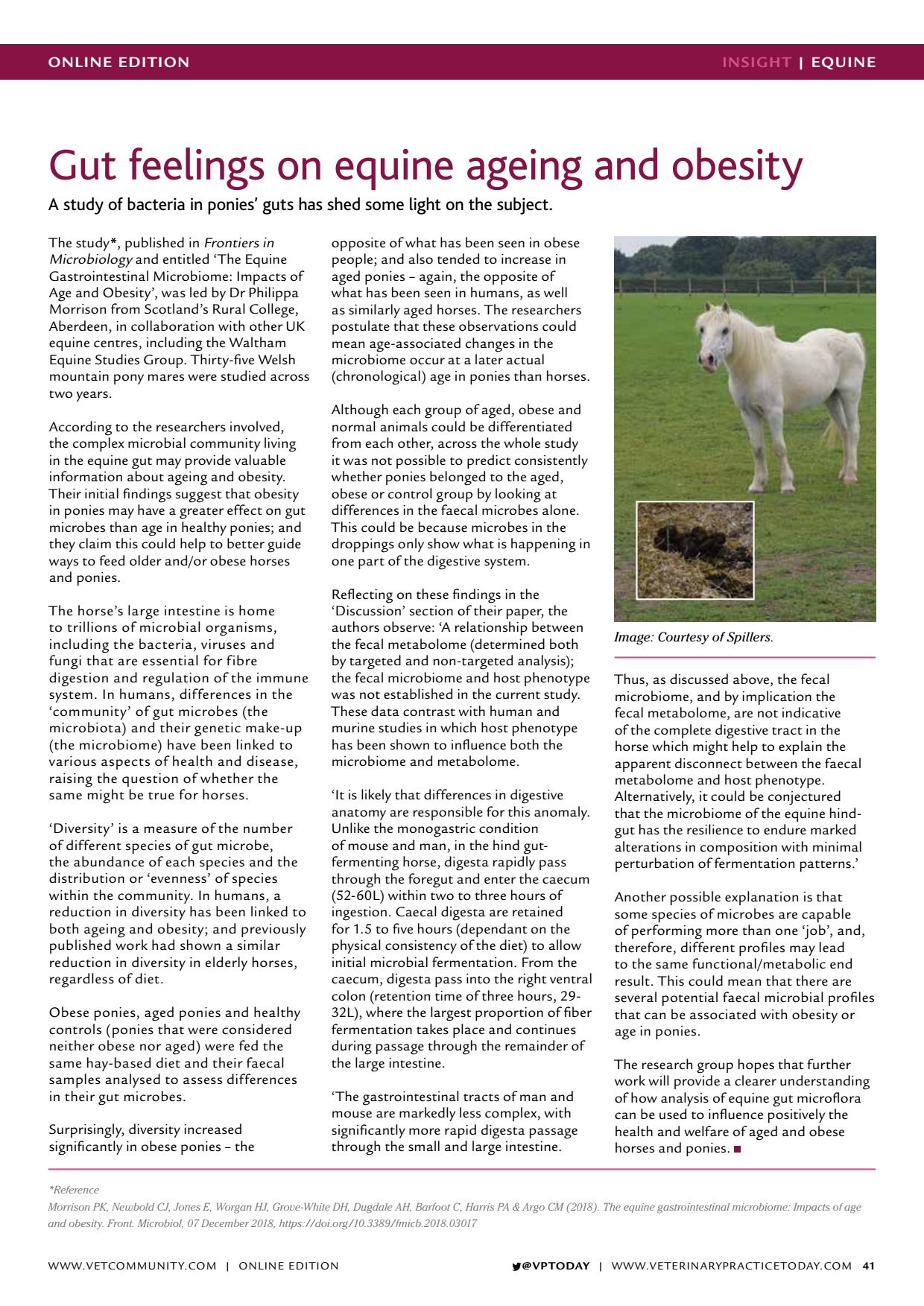feelings equine ageing
INSIGHT | EQUINE VPTODAY | WWW.VETERINARYPRACTICETODAY.COM 41 Gut feelings on equine ageing and obesity A study of bacteria in ponies guts has shed some light on the subject. The study , published in Frontiers in Microbiology and entitled The Equine Gastrointestinal Microbiome: Impacts of Age and Obesity, was led by Dr Philippa Morrison from Scotlands Rural College, Aberdeen, in collaboration with other UK equine centres, including the Waltham Equine Studies Group. Thirty-five Welsh mountain pony mares were studied across two years. According to the researchers involved, the complex microbial community living in the equine gut may provide valuable information about ageing and obesity. Their initial findings suggest that obesity in ponies may have a greater effect on gut microbes than age in healthy ponies; and they claim this could help to better guide ways to feed older and/or obese horses and ponies. The horses large intestine is home to trillions of microbial organisms, including the bacteria, viruses and fungi that are essential for f ibre digestion and regulation of the immune system. In humans, differences in the community of gut microbes (the microbiota) and their genetic make-up (the microbiome) have been linked to various aspects of health and disease, raising the question of whether the same might be true for horses. Diversity is a measure of the number of different species of gut microbe, the abundance of each species and the distribution or evenness of species within the community. In humans, a reduction in diversity has been linked to both ageing and obesity; and previously published work had shown a similar reduction in diversity in elderly horses, regardless of diet. Obese ponies, aged ponies and healthy controls (ponies that were considered neither obese nor aged) were fed the same hay-based diet and their faecal samples analysed to assess differences in their gut microbes. Surprisingly, diversity increased significantly in obese ponies the opposite of what has been seen in obese people; and also tended to increase in aged ponies again, the opposite of what has been seen in humans, as well as similarly aged horses. The researchers postulate that these observations could mean age-associated changes in the microbiome occur at a later actual (chronological) age in ponies than horses. Although each group of aged, obese and normal animals could be differentiated from each other, across the whole study it was not possible to predict consistently whether ponies belonged to the aged, obese or control group by looking at differences in the faecal microbes alone. This could be because microbes in the droppings only show what is happening in one part of the digestive system. Reflecting on these findings in the Discussion section of their paper, the authors observe: A relationship between the fecal metabolome (determined both by targeted and non-targeted analysis); the fecal microbiome and host phenotype was not established in the current study. These data contrast with human and murine studies in which host phenotype has been shown to influence both the microbiome and metabolome. It is likely that differences in digestive anatomy are responsible for this anomaly. Unlike the monogastric condition of mouse and man, in the hind gut- fermenting horse, digesta rapidly pass through the foregut and enter the caecum (52-60L) within two to three hours of ingestion. Caecal digesta are retained for 1.5 to five hours (dependant on the physical consistency of the diet) to allow initial microbial fermentation. From the caecum, digesta pass into the right ventral colon (retention time of three hours, 29- 32L), where the largest proportion of fiber fermentation takes place and continues during passage through the remainder of the large intestine. The gastrointestinal tracts of man and mouse are markedly less complex, with significantly more rapid digesta passage through the small and large intestine. Thus, as discussed above, the fecal microbiome, and by implication the fecal metabolome, are not indicative of the complete digestive tract in the horse which might help to explain the apparent disconnect between the faecal metabolome and host phenotype. Alternatively, it could be conjectured that the microbiome of the equine hind- gut has the resilience to endure marked alterations in composition with minimal perturbation of fermentation patterns. Another possible explanation is that some species of microbes are capable of performing more than one job, and, therefore, different profiles may lead to the same functional/metabolic end result. This could mean that there are several potential faecal microbial profiles that can be associated with obesity or age in ponies. The research group hopes that further work will provide a clearer understanding of how analysis of equine gut microflora can be used to influence positively the health and welfare of aged and obese horses and ponies. Reference Morrison PK, Newbold CJ, Jones E, Worgan HJ, Grove-White DH, Dugdale AH, Barfoot C, Harris PA & Argo CM (2018). The equine gastrointestinal microbiome: Impacts of age and obesity. Front. Microbiol, 07 December 2018, https://doi.org/10.3389/fmicb.2018.03017 Image: Courtesy of Spillers. WWW.VETCOMMUNIT Y.COM | ONLINE EDITION ONLINE EDITION
